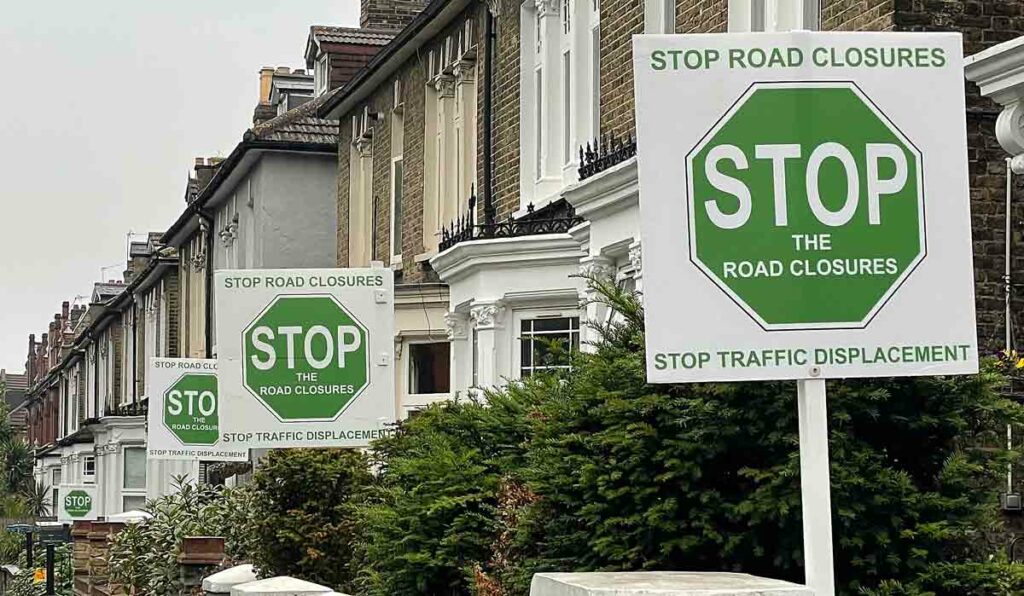
The High Court today (28 June) dismissed a legal challenge to Lambeth low traffic neighbourhoods (LTNs).
It rejected all four grounds for the challenge, but indicated that one might have been valid if it were not for the pandemic.
Cllr Claire Holland, leader of Lambeth council, commented: “We welcome the judge’s decisive ruling today, dismissing the claims on all counts.”
She said the council “has been clear from the start that we had to act swiftly and urgently in the face of the huge challenges that the coronavirus pandemic posed to our borough, and in particular the immediate risk of it making existing inequalities on our streets and in our neighbourhoods worse.
“The council has set out from the outset that implementing measures to make our streets safer and healthier was fully in line with statutory guidance and national policy objectives.
“We rejected any suggestion that these schemes are discriminatory in any way or were installed illegally.
“We’re glad that the judgement is clear on that, and particularly that considerations of equality were accounted for at the earliest stage of the LTN.
“The judgement also reinforces our approach of continuing to consider those objectives using data collected throughout the experimental period, ensuring that the impacts on those most at-risk remains front and centre of our approach.
“The start of the Covid-19 pandemic saw capacity on public transport reduced by up to 80 per cent to accommodate social distancing.
“With around 60 per cent of households in Lambeth not having access to a car, and with access typically lower for women, Black and disabled residents in particular, we needed to make our streets safer to enable them to walk, cycle, scoot or wheel safely in their local area and access local facilities during the pandemic.”
Holland said the council’s response was an emergency transport plan, “produced last summer for the benefit of all Lambeth’s residents but primarily focused at tackling the acute inequalities that we envisaged the pandemic would exacerbate in our borough”.
The plan included pavement widening, temporary walking and cycling infrastructure and low traffic neighbourhoods.
“The council is carrying out regular, detailed, open and transparent monitoring of the programme and has already taken on board feedback from local people to make improvements where necessary,” Holland said.
“We will now redouble our efforts to involve all of our communities in a conversation about how we rebalance our streets so that they are more equal, safer and put people first,” she added.
More than £35,000 was raised online by the OneLambeth campaign to fund the legal challenge by Sofia Sheakh, who lives on the edge of the Railton LTN.
OneLambeth said it was disappointed by the judgement and was talking to its legal team about an appeal.
The application for a judicial review of Lambeth council’s decisions was made by law firm Rook Irwin Sweeney LLP, who have also been instructed by a disabled resident of Hackney to challenge road closures made under that borough’s “school streets” scheme.
In both cases, it argues that the closures – which were implemented by way of experimental traffic orders – were enacted without consultation and without regard to the needs of disabled residents.
The OneLambeth campaign says LTNs in Lambeth were created without consultation and that they divide communities, discriminate against the elderly and disabled, hamper emergency services, increase congestion, damage businesses and heap pollution on schools and residents near main roads.
The campaign said that council leader Claire Holland’s reaction to the judgement was “disgusting”, prioritising the well, able and affluent, adding that “she laughs at residents [with] chronic lung disease who she pollutes”.
The judgement
In his judgement, Mr Justice Kerr said that the claims before him were among a dozen or more brought in respect of LTNs introduced in Lambeth and other London boroughs.
Both the council and the claimant employed QCs to make their case.
Justice Kerr rejected all four of the claimant’s grounds for complaint against the council, but he did say that one of them may well have been valid, but for the effect of the pandemic.
In a detailed account of the background and history of the introduction of Lambeth LTNs, he noted that, in plans made before the outbreak of Covid, the council was expecting a three-year timescale for the introduction of such measures.
He then highlighted guidance issued by the Secretary of State for Transport on 9 May last year. It said in its introduction that a “once in a generation opportunity” had arisen to “deliver a lasting transformative change in how we make short journeys in our towns and cities”.
It concluded: “The government therefore expects local authorities to make significant changes to their road layouts to give more space to cyclists and pedestrians”.
In another section, the government said: “Measures should be taken as swiftly as possible, and in any event within weeks, given the urgent need to change travel habits before the restart takes full effect.”
On 13 November last year, Justice Kerr said, the Secretary of State issued an amended version of the 9 May guidance. The words “Measures should be taken as swiftly as possible, and in any event within weeks, given the urgent need to change travel habits before the restart takes full effect”, were amended to: “Measures should be taken as swiftly as possible, but not at the expense of consulting local communities”.
From 30 November, Lambeth council officers updated their equality impact assessments (EQIA) for various LTNs.
For the Railton LTN, they said that feedback gathered since the trial was launched indicated some people had had to change routes to access essential services and support, including parents and carers of disabled children and disabled adults.
Feedback had also been received from disabled people who rely on motorised transport about the impact that the LTN has had on their journeys.
The officers said that “further data is being collected and mitigations developed and implemented accordingly”, adding that disability is a broad category and ongoing engagement and monitoring will be needed to identify impacts on different groups.
The council published a monitoring strategy on 4 December.
On 30 December, when the decision was taken to introduce the Railton LTN, it included a commitment to “undertake a non-statutory consultation exercise with local stakeholders prior to any decision being made moving to a permanent traffic order”.
Justice Kerr then detailed his reason for rejcting the claimant’s grounds for challenging the orders creating the Railton LTN.
First, he said of the claim that the LTN was not experimental at all: “I do not think there is any merit in these arguments”. He said council documents were “replete with references” to their experimental nature.
Second, he considered the claimant’s assertion that there should be a separate, bespoke impact assessment for each new LTN.
Lambeth council’s QC Tim Mould had submitted that the speed of delivery required by the statutory guidance had to be balanced against the need to understand the risks arising from displacement of traffic.
The guidance required the creation of LTNs within a matter of weeks. In practice, that precluded prior research and modelling; instead, traffic orders had to be put in place quickly and their impact measured, monitored and mitigated afterwards.
Justice Kerr said that because of the “unusual factual features” in this case, the council’s “equality impact assessment on a rolling basis” was acceptable.
These features included the urgency expressed in the statutory guidance, the “near stasis” of public transport and the need to restrain vehicle traffic in residential areas to allow walking and cycling to flourish.
“Those factors (all caused by the prevalence of the virus) propelled Lambeth to curtail its research and truncate the timescale, using experimental traffic orders.”
Had those factors been absent, said Justice Kerr, the council’s approach to equality assessment “might well not have passed the test of having ‘due regard’ to equality issues”.
He dismissed this ground of challenge to the orders.
Third, Justice Kerr said that he found the council’s submissions on claims it had not taken into account elements of the Road Traffic Regulation Act 1984 “compelling and unanswerable”.
He observed: “the very act of prohibiting rat running is intended to inconvenience the rat runners by keeping them out of the LTN, thereby probably lengthening their journey.”
Fourth, on the challenge of inadequate consultation, Justice Kerr agreed with Lambeth’s counsel that it was “without merit”.






